
Judge James Horton
James E. Horton was born in Limestone County, Alabama in 1872. He received a law degree from the Cumberland School of Law, then located in Tennessee, in 1899. He was elected to the Alabama Legislature in 1910 where he served for six years. In 1922 he was elected Circuit Judge. During the fifth year of his second term, 1933, the re-trial of Scottsboro Boy, Haywood Patterson, was transferred to his courtroom in Decatur, Alabama.
The Scottsboro Boys were 9 teenage black men falsely accused of attacking two women on a train in March of 1931. Although there was no evidence of their guilt, outside of the testimony of the two women, the men were quickly arrested and found guilty of the crime. By the time appeals were made, the case had gained national attention.
One of the women who had accused the young men of the attack testified in the retrial on Patterson’s behalf stating the accusations had been made up. Regardless of her testimony, in April of 1933 Haywood Patterson was again found guilty of the crime and sentenced to death. Because of the dangerously high tensions surrounding the case, Judge Horton postponed the retrials of the other young men.
On June 22 that same year, Judge Horton vacated the verdict of the jury with the following statement:
History, sacred and profane, and the common experience of mankind teach us that women of the character shown in this case are prone for selfish reasons to make false accusations both of rape and of insult upon the slightest provocation for ulterior purposes. These women are shown, by the great weight of the evidence, on this very day before leaving Chattanooga, to have falsely accused two negroes of insulting them, and of almost precipitating a fight between one of the white boys they were in company with and these two negroes. This tendency on the part of the women shows that they are predisposed to make false accusations upon any occasion whereby their selfish ends may be gained.
The Court will not pursue the evidence any further.
As heretofore stated the law declares that a defendant should not be convicted without corroboration where the testimony of the prosecutrix bears on its face indications of improbability or unreliability and particularly when it is contradicted by other evidence.
The testimony of the prosecutrix in this case is not only uncorroborated, but it also bears on its face indications of improbability and is contradicted by other evidence, and in addition thereto the evidence greatly preponderates in favor of the defendant. It therefore becomes the duty of the Court under the law to grant the motion made in this case.
It is therefore ordered and adjudged by the Court that the motion be granted; that the verdict of the jury in this case and the judgment of the Court sentencing this defendant to death be set aside and that a new trial be and the same is hereby ordered.Judge Horton
Judge Horton retired from politics in 1934, when he failed to be reelected as Circuit Judge. After retiring from politics, Judge Horton continued to practice law privately from his home. Judge James E. Horton passed away in March of 1972.
Haywood Patterson, along with seven of the other Scottsboro Boys, went on to be convicted and sentenced again to the death penalty. Their lawyer, Samuel Leibowitz, continued to file appeals and defend them in court, keeping them out of the electric chair. In October of 1976, the only living Scottsboro Boy, Clarence Norris, was pardoned by Governor George Wallace.
Resources
- Judge James E. Horton Collection
- The Trials of the Scottsboro Boys
- Scottsboro an American Tragedy, PBS


![[1933 UPI] Scottsboro boys with Leibowitz in jail](graphics/scottsboroboydpi250b.jpg)


